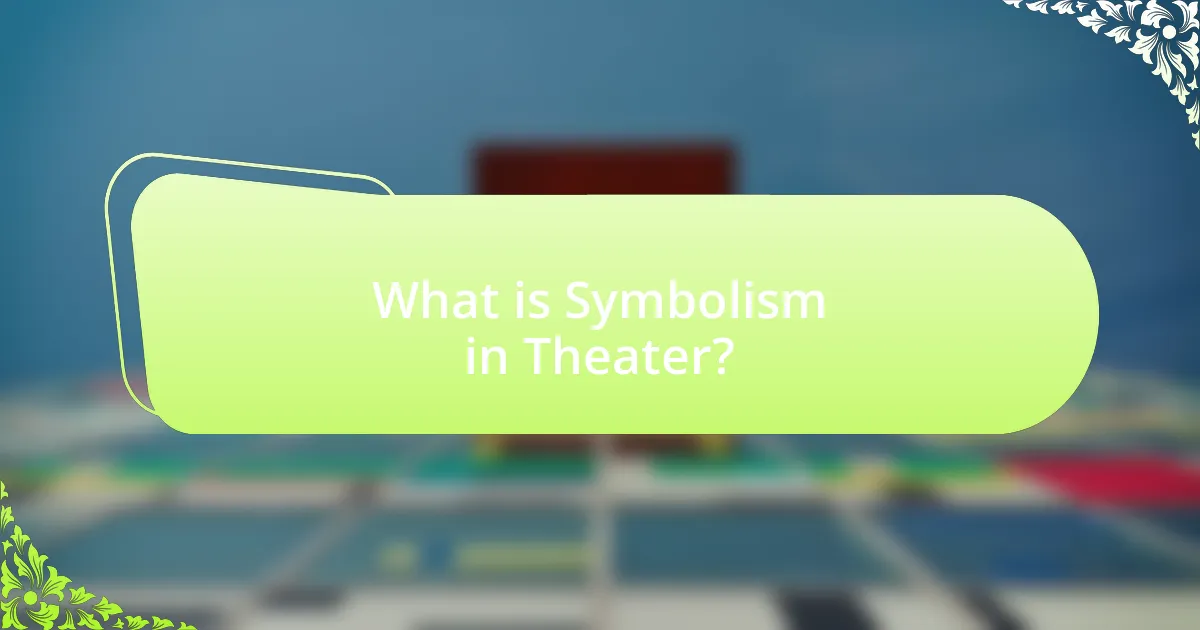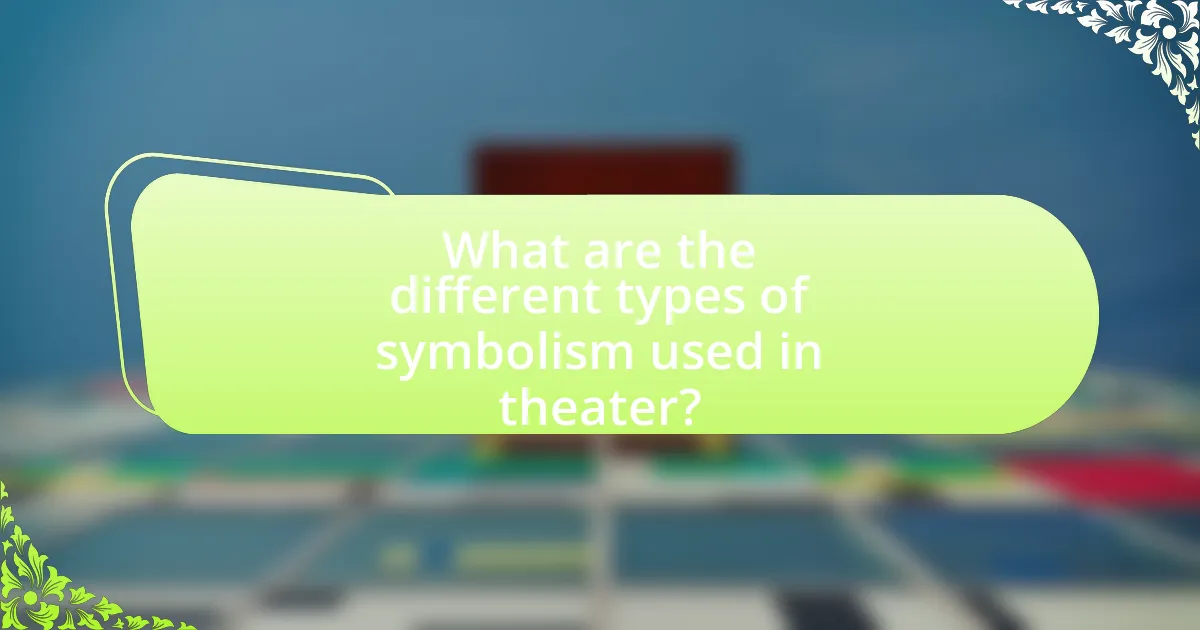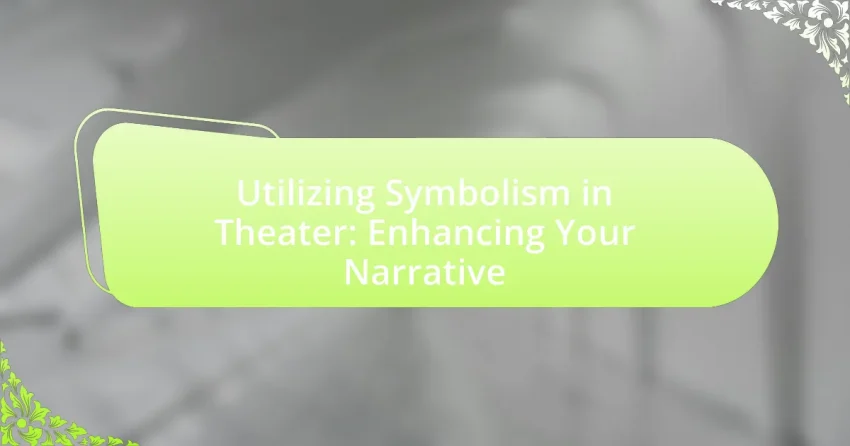The article focuses on the concept of symbolism in theater, emphasizing its role in enhancing narratives by conveying deeper meanings and emotions. It explores how playwrights and directors utilize symbols—such as objects, colors, and actions—to enrich storytelling and character development, while also influencing audience perception and emotional engagement. Key elements discussed include the types of symbolism, its impact on character journeys, and the historical contexts that shape its use. Additionally, the article provides practical tips for effectively integrating symbolism into theatrical scripts and highlights the importance of collaboration with designers to improve symbolic representation.

What is Symbolism in Theater?
Symbolism in theater refers to the use of symbols to convey deeper meanings and emotions beyond the literal interpretation of the text. This technique allows playwrights and directors to express complex ideas, themes, and character motivations through visual and auditory elements, such as props, colors, and music. For example, in Anton Chekhov’s plays, the use of the gun as a symbol foreshadows impending tragedy, illustrating how symbolism can enhance narrative depth and audience engagement.
How does symbolism enhance storytelling in theater?
Symbolism enhances storytelling in theater by providing deeper meaning and emotional resonance to the narrative. Through the use of symbols, playwrights can convey complex themes and ideas succinctly, allowing audiences to engage with the material on multiple levels. For instance, in Arthur Miller’s “Death of a Salesman,” the character of Willy Loman symbolizes the struggle of the American Dream, illustrating the broader societal issues of ambition and failure. This use of symbolism not only enriches the characters’ journeys but also invites the audience to reflect on their own experiences and societal values, thereby deepening the overall impact of the story.
What are the key elements of symbolism in theatrical narratives?
The key elements of symbolism in theatrical narratives include objects, colors, actions, and characters that represent deeper meanings beyond their literal interpretation. These elements serve to convey themes, emotions, and ideas, enhancing the audience’s understanding of the narrative. For instance, a red rose may symbolize love or passion, while a broken mirror can represent shattered identity or self-reflection. The use of symbolism allows playwrights to communicate complex concepts succinctly, engaging the audience on multiple levels and prompting them to explore the underlying messages within the performance.
How does symbolism influence audience perception?
Symbolism significantly influences audience perception by conveying deeper meanings and emotions beyond the literal narrative. In theater, symbols can represent complex ideas, themes, or character traits, allowing audiences to engage with the material on a more profound level. For instance, the use of a red rose often symbolizes love or passion, prompting viewers to interpret scenes with emotional resonance. Research indicates that audiences are more likely to remember and connect with performances that effectively utilize symbolism, as it enhances their understanding and emotional investment in the story. This connection is supported by studies in cognitive psychology, which show that symbolic representations can trigger emotional responses and facilitate memory retention, ultimately shaping how audiences perceive and interpret theatrical narratives.
Why is symbolism important in theatrical performances?
Symbolism is important in theatrical performances because it enhances the narrative by conveying deeper meanings and emotions that words alone cannot express. Through the use of symbols, such as colors, objects, or actions, playwrights and directors can create layers of meaning that resonate with the audience, allowing for a more profound engagement with the story. For instance, in Arthur Miller’s “Death of a Salesman,” the seeds that Willy Loman plants symbolize his hopes and dreams for success, illustrating the theme of unattainable aspirations. This use of symbolism not only enriches the characters’ experiences but also invites the audience to interpret and connect with the underlying messages of the performance.
What emotional responses can symbolism evoke in the audience?
Symbolism can evoke a range of emotional responses in the audience, including nostalgia, empathy, and introspection. For instance, the use of a red rose often symbolizes love and passion, triggering feelings of romance or longing in viewers. Similarly, a broken mirror may represent shattered dreams or self-reflection, prompting audiences to contemplate their own experiences and emotions. Research in psychology indicates that symbols can activate emotional memories, enhancing the audience’s connection to the narrative and deepening their overall experience. This connection is crucial in theater, where emotional engagement is essential for impactful storytelling.
How does symbolism contribute to character development?
Symbolism significantly contributes to character development by providing deeper insights into a character’s motivations, emotions, and transformations. For instance, a recurring symbol associated with a character can reflect their internal struggles or growth, allowing the audience to understand their journey on a more profound level. In literature and theater, symbols such as objects, colors, or actions often serve as metaphors for a character’s traits or changes, enhancing the narrative’s emotional impact. This technique is evident in works like “The Great Gatsby,” where the green light symbolizes Gatsby’s unattainable dreams, illustrating his character’s longing and ultimate disillusionment. Such symbolic representations not only enrich the character’s portrayal but also engage the audience in interpreting the underlying themes of the narrative.

What are the different types of symbolism used in theater?
The different types of symbolism used in theater include visual symbolism, verbal symbolism, and situational symbolism. Visual symbolism involves the use of props, costumes, and set design to convey deeper meanings; for example, a red curtain may symbolize passion or danger. Verbal symbolism occurs through dialogue and monologues where characters use metaphors and similes to express complex ideas, such as a character comparing love to a battlefield. Situational symbolism arises from the context of the plot, where specific events or actions represent larger themes, like a character’s fall symbolizing loss of innocence. Each type of symbolism enhances the narrative by adding layers of meaning and emotional depth, making the audience engage more profoundly with the story.
How do visual symbols function in theatrical productions?
Visual symbols in theatrical productions serve to convey themes, emotions, and character traits, enhancing the narrative without the need for dialogue. These symbols, such as colors, props, and costumes, provide visual cues that help the audience interpret the story and connect with the characters on a deeper level. For instance, the use of red to symbolize passion or danger can immediately communicate a character’s emotional state or foreshadow events. Historical examples include the use of masks in Greek theater, which conveyed specific character traits and societal roles, thus enriching the audience’s understanding of the narrative.
What role do colors play as symbols in theater?
Colors serve as powerful symbols in theater, conveying emotions, themes, and character traits. For instance, red often symbolizes passion or danger, while blue can represent calmness or sadness. The use of colors in set design, costumes, and lighting enhances the narrative by visually communicating the underlying emotional landscape of the story. Historical examples include the use of black in tragedies to signify mourning and white in comedies to denote purity or innocence. This symbolic use of color helps audiences quickly grasp the mood and intentions of the characters, thereby enriching the overall theatrical experience.
How can props serve as symbols in a narrative?
Props can serve as symbols in a narrative by representing themes, emotions, or character traits that enhance the story’s depth. For instance, a broken mirror can symbolize shattered identity or self-perception, while a red rose may signify love or passion. These symbolic props provide visual cues that reinforce the narrative’s emotional landscape, allowing the audience to engage more deeply with the characters’ journeys. The use of props as symbols is a well-established technique in theater, as seen in productions like “Hamlet,” where Yorick’s skull symbolizes mortality and the inevitability of death, thereby enriching the thematic complexity of the play.
What are the common themes represented through symbolism?
Common themes represented through symbolism include the struggle between good and evil, the passage of time, and the quest for identity. In theater, these themes are often conveyed through specific symbols such as light and darkness to represent moral choices, clocks or seasons to signify the inevitability of change, and mirrors or masks to explore self-perception and societal roles. For instance, in Shakespeare’s “Macbeth,” the recurring motif of blood symbolizes guilt and the moral consequences of ambition, reinforcing the theme of the destructive nature of unchecked desire. This use of symbolism allows audiences to engage with deeper meanings and emotional truths within the narrative.
How does symbolism reflect societal issues in theater?
Symbolism in theater serves as a powerful tool to reflect societal issues by using objects, characters, or actions to represent broader concepts and themes. For instance, in Arthur Miller’s “Death of a Salesman,” the character Willy Loman symbolizes the American Dream and its disillusionment, highlighting issues such as economic struggle and societal expectations. This use of symbolism allows audiences to engage with complex social realities, making abstract problems more tangible and relatable. Historical context, such as the post-World War II era in which Miller wrote, further reinforces the connection between the symbolism in the play and the societal issues of that time, illustrating how theater can critique and comment on the human experience.
What historical contexts influence the use of symbolism?
Historical contexts that influence the use of symbolism include cultural movements, religious beliefs, and socio-political events. For instance, the Renaissance period saw a revival of classical themes and humanism, leading to the use of symbols that represented individualism and enlightenment in theater. Additionally, the Romantic era emphasized emotion and nature, using symbolism to convey deeper feelings and ideas. The impact of World War I and II also shaped symbolism in theater, as playwrights used symbols to critique society and express the trauma of war. These contexts demonstrate how historical events and cultural shifts directly inform the symbolic language used in theatrical narratives.

How can playwrights effectively utilize symbolism?
Playwrights can effectively utilize symbolism by embedding objects, actions, or characters that represent larger themes or ideas within their narratives. This technique allows for deeper emotional resonance and enhances audience engagement by prompting them to interpret and connect with the underlying messages. For instance, in Arthur Miller’s “Death of a Salesman,” the seeds that Willy Loman plants symbolize his hopes and dreams for success, illustrating the broader theme of the American Dream’s unattainability. Such concrete examples demonstrate how symbolism can enrich storytelling by providing layers of meaning that resonate with the audience’s experiences and perceptions.
What techniques can be employed to integrate symbolism into scripts?
Techniques to integrate symbolism into scripts include the use of recurring motifs, character names, and visual imagery. Recurring motifs, such as specific objects or phrases, can create a thematic resonance throughout the narrative, reinforcing the underlying message. Character names can also serve as symbols; for example, a character named Hope may embody optimism, while a character named Shadow may represent despair. Visual imagery, such as colors or settings, can evoke specific emotions and symbolize broader concepts, like red for passion or a stormy setting for turmoil. These techniques enhance the narrative by adding depth and layers of meaning, allowing audiences to engage with the script on a more profound level.
How can symbolism be subtly woven into dialogue?
Symbolism can be subtly woven into dialogue by incorporating metaphors, allusions, and specific word choices that evoke deeper meanings without overtly stating them. For instance, a character might refer to a “storm” when discussing personal turmoil, suggesting chaos and conflict without explicitly stating it. This technique allows the audience to infer the underlying themes and emotions, enriching the narrative. The effectiveness of this approach is supported by literary analysis, which shows that nuanced dialogue can enhance character development and thematic depth, as seen in works by playwrights like Tennessee Williams and Arthur Miller, who often used symbolic language to convey complex ideas.
What are the best practices for using symbolism in stage directions?
The best practices for using symbolism in stage directions include ensuring clarity, consistency, and relevance to the narrative. Clarity allows the audience and actors to easily interpret the symbolic elements, while consistency maintains the thematic integrity throughout the performance. Relevance ensures that the symbols enhance the story rather than distract from it. For instance, in Arthur Miller’s “Death of a Salesman,” the use of the garden symbolizes Willy Loman’s dreams and failures, effectively reinforcing the play’s themes of aspiration and disillusionment. This approach demonstrates how well-integrated symbolism can deepen the audience’s understanding of the characters and their journeys.
What challenges do playwrights face when using symbolism?
Playwrights face several challenges when using symbolism, primarily related to audience interpretation and clarity of intent. The use of symbolism can lead to varied interpretations, making it difficult for playwrights to ensure that their intended message is conveyed effectively. For instance, a symbol that resonates with one audience member may be completely misunderstood by another, leading to confusion about the narrative’s core themes. Additionally, excessive reliance on symbolism can detract from character development and plot progression, as audiences may focus more on deciphering symbols than engaging with the story itself. This challenge is compounded by the need for balance; playwrights must integrate symbolism in a way that enhances rather than overshadows the dialogue and action on stage.
How can ambiguity in symbolism lead to misinterpretation?
Ambiguity in symbolism can lead to misinterpretation by allowing multiple meanings to coexist, which can confuse the audience. When symbols are not clearly defined, different viewers may derive varied interpretations based on their personal experiences or cultural backgrounds. For instance, in theater, a single symbol like a red rose can represent love, passion, or even secrecy, depending on the context and the audience’s perspective. This multiplicity of meanings can result in misunderstandings of the intended message, as evidenced by various productions where audience reactions diverged significantly from the creators’ intentions. Such misinterpretations can dilute the narrative’s impact and lead to a disconnect between the performers and the audience.
What strategies can be used to clarify symbolic meanings for the audience?
To clarify symbolic meanings for the audience, one effective strategy is to provide contextual explanations within the narrative. This can be achieved through dialogue, character actions, or visual cues that explicitly connect symbols to their intended meanings. For instance, in Arthur Miller’s “Death of a Salesman,” the use of the seeds symbolizes Willy Loman’s desire to leave a legacy; this is reinforced through his conversations about planting and growth, making the symbolism clear to the audience. Additionally, employing recurring motifs throughout the performance can help solidify the audience’s understanding of the symbols, as seen in the use of light and darkness in Shakespeare’s “Macbeth” to represent moral ambiguity. These strategies ensure that the audience can grasp the deeper meanings behind the symbols presented in the theater.
What practical tips can enhance the use of symbolism in theater?
To enhance the use of symbolism in theater, creators should focus on integrating symbols that resonate with the themes and emotions of the narrative. This can be achieved by selecting objects, colors, or actions that reflect the characters’ inner conflicts or societal issues, thereby deepening the audience’s understanding. For instance, the use of a red rose can symbolize love or passion, while a broken mirror might represent shattered identity. Additionally, consistent use of these symbols throughout the performance reinforces their significance, allowing the audience to draw connections and interpretations. Historical examples, such as the use of the green light in “The Great Gatsby” adaptations, illustrate how a single symbol can encapsulate complex themes of aspiration and unattainable dreams.
How can collaboration with designers improve symbolic representation?
Collaboration with designers can significantly enhance symbolic representation by integrating visual elements that align with the narrative’s themes. Designers bring expertise in visual communication, allowing for the creation of symbols that resonate with the audience and deepen their understanding of the story. For instance, a study by the American Theatre Magazine highlights that effective collaboration between directors and designers leads to cohesive visual storytelling, where symbols are not only aesthetically pleasing but also contextually relevant, thereby enriching the audience’s emotional experience. This synergy ensures that the symbolic elements are thoughtfully crafted and strategically placed, reinforcing the narrative’s core messages.
What resources are available for playwrights to explore symbolism further?
Playwrights can explore symbolism further through various resources, including books, online courses, and workshops. Notable books such as “The Symbolism of the Theatre” by John Russell Brown and “The Art of Dramatic Writing” by Lajos Egri provide foundational insights into the use of symbolism in drama. Online platforms like Coursera and MasterClass offer courses specifically focused on dramatic writing and symbolism, taught by experienced playwrights and educators. Additionally, workshops hosted by theater companies often focus on the practical application of symbolism in writing and performance, allowing playwrights to engage directly with the concept in a collaborative environment. These resources collectively enhance a playwright’s understanding and application of symbolism in their narratives.
